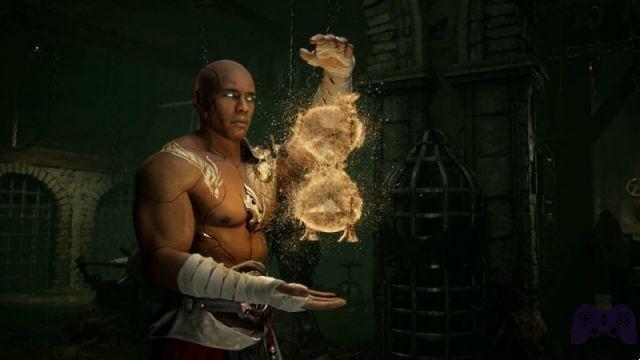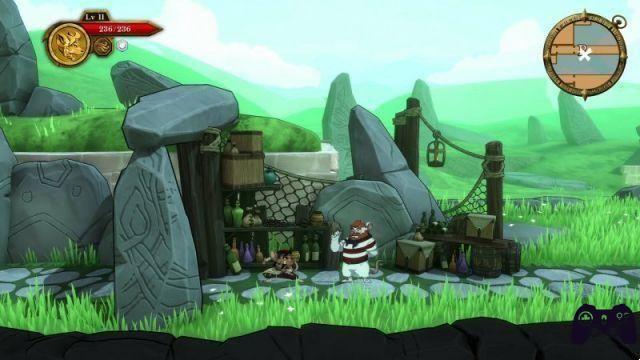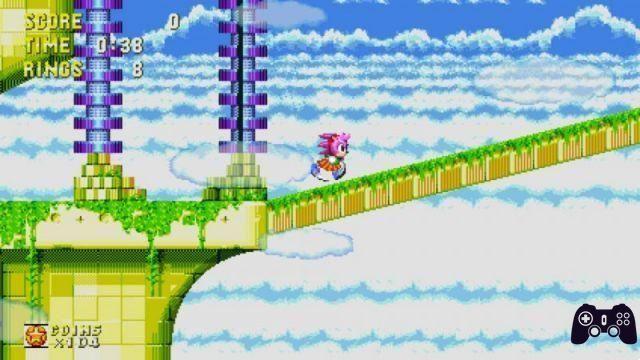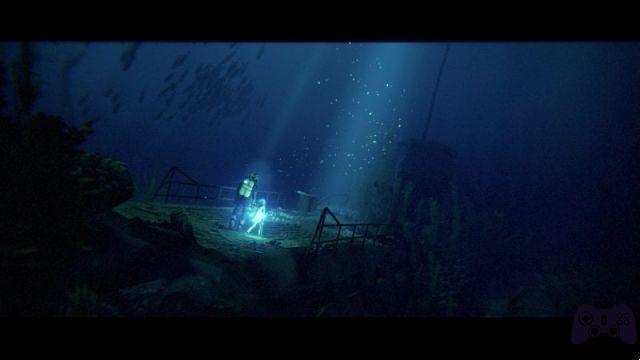If up until a couple of years ago we had sworn that almost all of the biggest names in fighting games would soon reappear within a few months of each other, you would have thought we were crazy. Instead, due to some strange alignment of the planets, virtually every major developer has decided to return to the field within a dozen months. Street Fighter 6 proved to be above even the highest expectations, raising the bar for the entire competition; Tekken 8 arrives next year, stepping on the accelerator aggressively and with an impressive technical sector; Riot Games has taken a step forward with its Project L, increasingly refined with each presentation; even SNK is about to bring the Fatal Fury series back to life, while the normally very active Arc System is certainly hiding something in the shadows...
He's obviously slipped into all this fighting goodness too. netherrealm: a team that represents the "western" backbone of the genre and that has been breaking sales records with its games for years. However, in the face of such ruthless competition, many doubts arose about the new Mortal Kombat 1, probably also due to certain defects that the American team never managed to fully overcome despite the obvious evolution over the years.
It's not that the most recent Mortal Kombat games are bad, on the contrary, from number nine onwards the series has taken giant steps forward, always managing to shine more for the fun it offers than for the splatter element that has always distinguished it. However, according to many, Mortal Kombat has always lacked those technical refinements and systems capable of making them truly worthy of the emperors of the category. With Capcom back in force and an army of fierce opponents closing in, NetherRealm undoubtedly needed to make a leap in quality to stay on top.
Mortal Kombat 1 is not just a sequel - because it is a sequel to the eleventh and not a reboot, despite the name - but rather a kind of rebirth of the series from a mechanical point of view, with largely revamped systems and a huge variety. which offers the arrival of a very important new jewel. We played it for several hours trying to analyze every detail and today, in this Mortal Kombat 1 review, we will try to explain to you why, abandoning much of what was done in the immediately previous chapter, the game managed to grow exponentially and fall. However, do not despair, because the positive sides significantly overshadow the negative ones.
Narrative: Shang, dismantle everything.

Let's start from an element that is normally completely insignificant in any fighting game, namely the plot. Very few approach this complex genre with the intention of enjoying a high-level story, however, recent evolution has led many titles to pay much more attention to the single-player elements, sometimes even giving life to universes worthy of be explored in depth. Now, Mortal Kombat already has a universe, it just hasn't been perfected over the years... For their part, the scriptwriters have also tried to make sense of the whirlwind of events involving the characters of the saga. , and yet, even with the best of intentions, it was a mission nothing short of impossible from the start.
The reason? That Mortal in the name has always forced NetherRealm to slaughter characters from chapter to chapter, however the popularity of the series (and the need to continue it, given sales) has inevitably inserted it into a loop of events that rival the worst. comic book mistakes in the market. All the expedients have already been used to kill and magically bring this or that protagonist back to life, so with the last chapter the house has opted for the only possible solution capable of giving meaning to the narrative again: the multiverse.
Mortal Kombat 1, in fact, is not a real reboot, but rather It directly follows the events of the previous chapter., with a now divine Liu Kang who has decided to restart the universe in the hope of not falling back into the classic spiral of violence and death that he has already experienced too many times. Obviously everything goes to hell in a very short time, due to a mysterious adversary apparently determined to return power to all those supervillains that good old Liu had downplayed in the timeline. As usual, therefore, you will face several chapters in the role of this or that fighter, carrying out a story that constantly navigates between the absurd and the bizarre.

Be careful, Story Mode is not really unpleasant: it is an adventure of about four hours full of excellently crafted films, which manages to entertain thanks to strong self-citation and a good mix of spectacle and humor. However, in terms of actual plot quality, we're at an all-time low; Here we return to the glories of the first three-dimensional Mortal Kombat, a cosmic fight where any drama is eliminated from the events by a universe in which almost anything can now happen without real consequences. Perhaps it was an inevitable degeneration, given the brand's long survival, but this awareness does not bode well for the future. If nothing else, it's nice to see how the writers have at least attempted to give more central roles to characters who were often mistreated in previous chapters; It helps you swallow moments that will make you shake your head more than necessary.
However, the game's amount of single-player content is very respectable: in addition to the campaign, this Mortal Kombat features a mode called "invasions", which is updated from season to season with new explorable maps and sees the player develop their fighters with each battle to obtain cosmetic items, costumes and other surprises; The classics add to this novelty. towers with endings dedicated to each warrior, less interesting, but still essential. In general they are decent extras, although the invasion mode disappointed us a little due to the repetitiveness of the battles and the level of difficulty that was really too low (also plagued by some really annoying special battle conditions). We also do not believe that forcing the player to play for a long time unlock some Kameos (the assists mentioned at the beginning of the article) is a great idea for competitive, even though a handful of hours are enough to achieve practically all of them. To be honest, it seems like the single-player game content outside of the main campaign was developed a bit hastily, without the care normally expected of Ed Boon's house. The tutorials, however, are more than good, complete and perfectly capable of explaining the basic concepts in detail even to beginners (perhaps something more could have been done in the tests dedicated to individual fighters, but that's all).
As for the internal stores, the situation seems much more honest to us than in Mortal Kombat 11 at the moment, because both online and the rest of the modes usually give a good amount of resources and objects to the player. He seasonal store The one where you can spend coins only increases the speed with which costumes and customization items are unlocked, and has fairly balanced costs. Yes, as expected, there are costumes that can only be purchased with premium currency, however in this regard NetherRealm seems to have learned its lesson after the criticism received in the past.
Gameplay: It's Mohrtal baybee!

If you've been following the evolution of NetherRealm's Mortal Kombat for a while, you'll surely know that 9 represented the turning point between the old and the new course, finally giving the series that solidity in gameplay necessary to consolidate a community of expert and competitive players. . oriented. That said, NetherRealm took a long time to find its footing, with some disastrous stumbles when it came to the overall balance of its titles. To summarize, some characters in the first Injustice and the tenth and ninth chapters of Mortal are so excessive that they are often removed by fans as a clear example of "how not to balance a fighting game", and even in the Most Of the balanced games in the house always take a while before solving certain situations (sometimes only to then remix them with DLC characters).
Curiously, however, Mortal Kombat fans seem to put some of the team's craziest games on a pedestal, perhaps due to the general flattening of the characters perceived in Mortal Kombat 11, which greatly limited the spectacularity of the combos and was focused on core mechanics. , only to return to a more similar view after the protests. With Mortal Kombat 1, NetherRealm was faced with a crossroads: continue down a more manageable path for competitive play, but risk producing a fighting game less exciting than those of the past, or not care and focus everything on pure fun. To find an answer, the developers followed a path that was honestly difficult to predict, even changing the fundamental elements of the series with the addition of a character assistance system called Kameo System.

For those who don't know it, it may not seem like such a revolutionary element, but in reality a fighting game with assists tends to be an almost unmanageable monster in terms of balance. Calculating in detail all the effects of skills that can be activated during, before and after moves is a titanic task that almost no one has managed to complete without serious oversights. However, some of the most played fighting games of all time, such as Marvel vs Capcom, are entirely structured around systems of this type and are still considered excellent titles, despite their imbalances.
To avoid unmanageable situations, NetherRealm has decided to approach the support system in a slightly different way: only one selectable Kameo character per fighter from a not excessively large list, with multiple abilities (all of which can be activated in battle without need). to select them) for each of them. In this way, the team was able to calculate each "partner" based on the synergies with the different characters, avoiding unexpected and unstoppable interactions. Or rather, I should have; But the truth is that, even with a smaller number of variables to take into account, the developers at NetherRealm couldn't manage everything perfectly, because they overindulged in assigning useful abilities to the different Kameos. Additionally, to make the roster more varied and enjoyable, NetherRealm has also given each of the 23 main warriors a really huge number of combinations, special moves and even aerial combos (which were practically lost in eleven).

From what has just been said, many will expect a disaster, but, as usual, calibrating the power of the roster upwards causes a kind of stagnation situation in which if the bulk of the fighters are excessively strong, everything tends to balance out. more or less. less automatically. Thus, Mortal Kombat 1 miraculously manages to have several warriors equipped with tools that in any other game would make them nearly untouchable in competitive play, and still remain manageable overall. By God, we are far from being a flawless game: the presence of numerous Kameos capable of constantly pressuring or blocking the enemy makes certain characters focus on setups (skills that force the opponent to defend themselves from difficult situations or suffer damage after an increase , or a stun of some kind) like Kenshi or Geras who are really hard to stop, damage often doesn't scale logically (leading to some combos easily dealing over 60% when they shouldn't), and certain assists that should be stopped by internal mechanics that have already been exploited to execute series of blows that are literally impossible to defend against (Cyrax and Jax's unstoppable blow above all, but which will surely get worse as time goes by); However, these cracks can be papered over with some healthy patches, and even in its current state NertherRealm's work remains a joy to both play and watch in action. A system like this, however unpredictable, still has incredible potential for development in the hands of the most skilled players, and it's been a long time since we've seen a Mortal Kombat with such a mix of potential and flexibility.
At least, the fundamental mechanical bases have remained more or less the same: the game uses for the umpteenth time the target combo system, which reads inputs in series without worrying too much about the moment of insertion, but requires some precision in complex combos; parrying is still tied to a button - which also allows you to cancel shots to advance faster - and, outside of the use of Kameos, the combat rhythms don't differ much from previous chapters (although the overall speed of the matches is significantly faster than the from Mortal Kombat 11). The news here is mainly related to defensive mechanics: You can perform high parries that give you an advantage against aerial attacks, perfect parries that are a little more relaxed than before and more important than ever, and it's even possible to follow up a hook with some sort of aerial dash if you spend gauge to do so. so. Speaking of the bar, it can obviously still be used to perform upgraded versions of special moves or to break enemy combos, although in this case it takes three notches to do so. We consider this a good choice, considering the speed at which it fills up and the tactical need to adjust your resources during a match. Just think, X-ray attacks have also been revived, here called Fatal Blow and can still be activated only once you reach the end of your hit points. In simple terms, NetherRealm didn't remove mechanics, it just added things, and in doing so has perhaps created its best game yet in terms of pure gameplay. Now we just need to see if they will be able to control this crazy horse through updates, or if they will completely lose control. The team will have to be more careful than ever with DLC characters and fixes so as not to lose sight of a fighting game that, in our opinion, still has considerable potential to evolve.
Technical section and netcode: beauties in plastic pose

We move aen línea, cross and delight (especially cross) of the genre, especially in the recent period. NetherRealm, fortunately, does not disappoint when it comes to netcode, and Mortal Kombat once again boasts extremely solid recoil, which has never created any special problems for us during matches. Also interesting is the presence of prizes for positions in ranked matches in the form of costumes, which encourage online play and allow those who are not interested in invasion mode to get customizations of their favorite warrior.
The lobbies, however, are tremendously classic and far from what we saw in Street Fighter. Here there are no alternative activities, specific filters for connections, or particular forms of communication, only the possibility of inviting other players and the classic matchmaking. Furthermore, the developers' decision to activate online communication with microphones by default is incomprehensible. It can be disabled from the menu, for God's sake, but the active setting can lead to some pretty absurd online situations and surely could have been avoided.

Nothing to say about him technical sector: Graphically the game defends itself very well, due to a notable level of detail in settings and characters, and fantastic facial and cutscene animations. Notice what we wanted to specify? Yes, because the combat once again does not lack the rigid and clumsy animations for which the series is known, although it must be said that the general quality has increased a lot compared to the previous chapters. By now, in any case, it is very clear how NetherRealm deliberately inserts them into its games as a kind of "homage" to the early days of the series, because you only have to watch a couple of scenes in between to realize how The animators of the house are found in highly qualified realities. Optimization on PC during battles is also good, although the frame rate drops drastically when exploring Invasions mode and in movies. A strange freezing issue with the latter present during early access was also fixed with the latest patch, which also added a good number of selectable graphical options, so at least NetherRealm was well aware of what the port's shortcomings were and already has intervened to fix the situation. However, the overall cleanliness is not exceptional: the reason we accuse the new modes of "rushed development" is also the presence of some bugs, which we are not used to seeing in NetherRealm productions. Nothing serious, but we normally expect another level of polish from a team with this level of experience.
Conclusions
Tested version PC with Windows digital delivery Steam, epic games store Holygamerz.com 8.0 Readers (35) 8.5 your voteWith Mortal Kombat 1 NetherRealm managed to surprise us both positively and negatively: from a playable point of view it is clearly the chapter with the greatest potential in the series, as well as one of the most fun of all time, and it manages to maintain a certain general character. balance despite a balance that is far from perfect. However, content-wise, the game is quite flat and the invasion mode in particular seemed quite rushed and repetitive. Overall, however, it's a high-quality fighting game, a must-have for any fan of the brand and probably capable of converting even the most skeptical. Now it only remains to be seen if Ed Boon and his men will be able to tame the crazy horse that they themselves have created by properly managing future updates and the long-awaited DLC characters. We hope so, because in our opinion this Mortal Kombat still has considerable potential to evolve.
PRO
- The most flexible combat system with the most potential in the saga
- Varied and substantial squad, significantly enriched by the presence of Kameo
- Technically always very impressive.
- Strong network code
AGAINST
- The extra modes are quite disappointing, especially the Invasions.
- Balance already seems like a utopia
- Less cleaning and general care than we expected.






